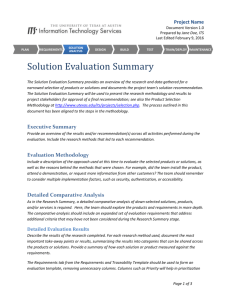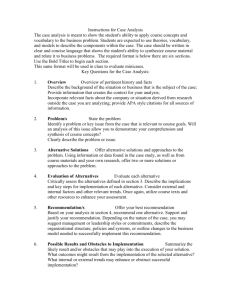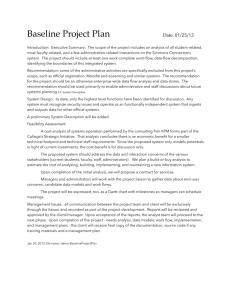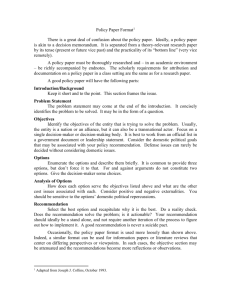Project Name
advertisement
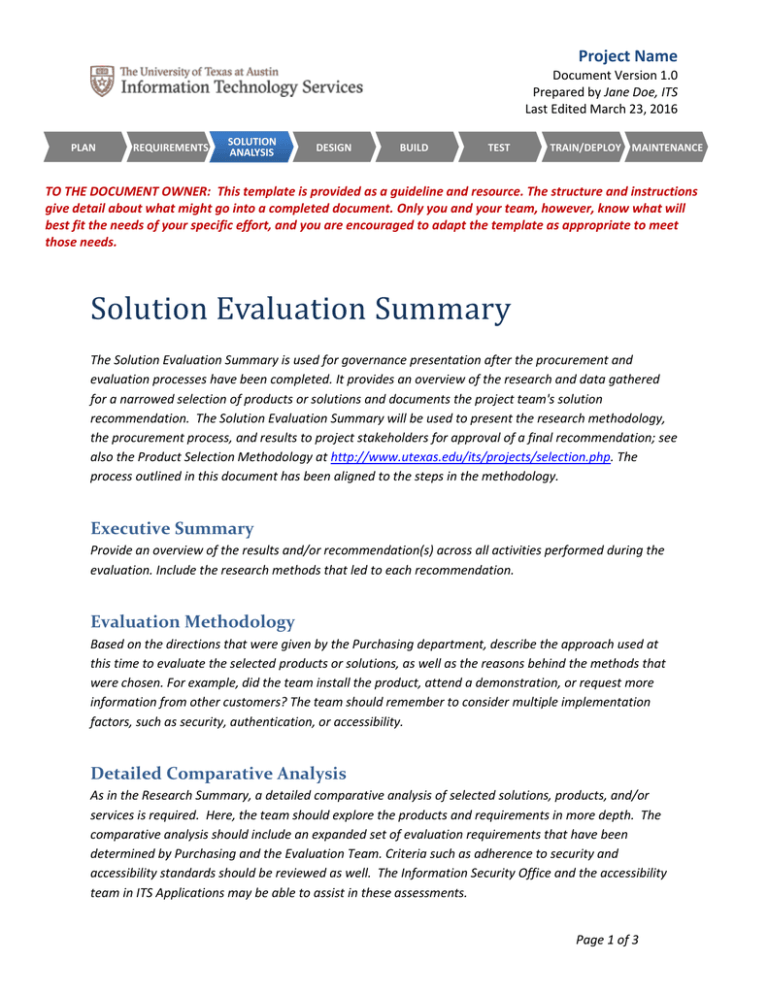
Project Name Document Version 1.0 Prepared by Jane Doe, ITS Last Edited March 23, 2016 PLAN REQUIREMENTS SOLUTION ANALYSIS DESIGN BUILD TEST TRAIN/DEPLOY MAINTENANCE TO THE DOCUMENT OWNER: This template is provided as a guideline and resource. The structure and instructions give detail about what might go into a completed document. Only you and your team, however, know what will best fit the needs of your specific effort, and you are encouraged to adapt the template as appropriate to meet those needs. Solution Evaluation Summary The Solution Evaluation Summary is used for governance presentation after the procurement and evaluation processes have been completed. It provides an overview of the research and data gathered for a narrowed selection of products or solutions and documents the project team's solution recommendation. The Solution Evaluation Summary will be used to present the research methodology, the procurement process, and results to project stakeholders for approval of a final recommendation; see also the Product Selection Methodology at http://www.utexas.edu/its/projects/selection.php. The process outlined in this document has been aligned to the steps in the methodology. Executive Summary Provide an overview of the results and/or recommendation(s) across all activities performed during the evaluation. Include the research methods that led to each recommendation. Evaluation Methodology Based on the directions that were given by the Purchasing department, describe the approach used at this time to evaluate the selected products or solutions, as well as the reasons behind the methods that were chosen. For example, did the team install the product, attend a demonstration, or request more information from other customers? The team should remember to consider multiple implementation factors, such as security, authentication, or accessibility. Detailed Comparative Analysis As in the Research Summary, a detailed comparative analysis of selected solutions, products, and/or services is required. Here, the team should explore the products and requirements in more depth. The comparative analysis should include an expanded set of evaluation requirements that have been determined by Purchasing and the Evaluation Team. Criteria such as adherence to security and accessibility standards should be reviewed as well. The Information Security Office and the accessibility team in ITS Applications may be able to assist in these assessments. Page 1 of 3 Project Name Document Version 1.0 Other criteria which may be worthy of inclusion and documentation include: Will the product require changes to existing business processes? If so, what changes, at roughly what cost, and how closely has this been reviewed? How will product upgrades be handled? Are there costs associated with upgrading? Who will determine the timing of upgrades? What product support options are available? What are the costs and criteria for different levels of support? What documentation is available for the product? Is there a strong user community or other source of assistance for product questions and problems? For a proprietary product, what is the risk that the product will be discontinued, e.g., in five or ten years? How stable is the provider company, e.g., in terms of finances, age, product adoption? Detailed Evaluation Results Describe the results of the research completed. For each research method used, document the most important take-away points or results, summarizing the results into categories that can be shared across the products or solutions. Provide a summary of how each solution or product measured against the requirements. The Requirements tab from the Requirements and Traceability Template should be used to form an evaluation template, removing unnecessary columns. Columns such as Priority will help in prioritization and should be used in the evaluation. Additional columns should be added to capture how each product or solution meets, partially meets, or does not meet the requirements. Alternatively, there are other approaches that the team can use, such as using Harvey Balls (http://en.wikipedia.org/wiki/Harvey_Balls) to summarize the different levels of comparison. For proprietary and open source solutions, indicate the difference between criteria which are met out of the box, which require configuration (using built-in product configuration options), and which require customization (new code will be developed or existing code will be modified). It may also be helpful to indicate a rough sizing for customization work, if possible. Evaluate Costs From the vendor quotes that that were analyzed by Purchasing and the Evaluation Team, develop an estimate of cost for the solution or product, including license, software maintenance/support, hardware, personnel, long-term maintenance, etc. A sample table is provided below. Implementation Cost (one time) Hardware/Hosting Software License Features/Enhancements Configuration/Customization Technical Support Training Solution Evaluation Summary Product 1 Product 2 $_,___ $_,___ $_,___ $_,___ $_,___ $_,___ $_,___ $_,___ $_,___ $_,___ $_,___ $_,___ Page 2 of 3 Project Name Document Version 1.0 Estimated Total Implementation Costs Maintenance Cost (annually) Hardware/Hosting Software License Maintenance Technical Support Training Estimated Total Annual Costs $_,___ $_,___ $_,___ $_,___ $_,___ $_,___ $_,___ $_,___ $_,___ $_,___ $_,___ $_,___ $_,___ $_,___ Detailed Recommendation Document a detailed recommendation of the product or solution determined by the comparative analysis and the procurement process. Provide a summary of results found, including advantages and disadvantages of the recommended product or solution. For any alternatives to be considered if the primary recommendation is not available, also document details and criteria for selection over the primary recommendation. Risks Document all risks identified during the evaluation. An example risk could be that there is an inconsistent software release schedule or that accessibility testing was not completed during the evaluation. Appendix Include detailed research results as appropriate. This should include the Evaluation Requirements Matrix. Revision History Version Date Updater Name V1 Solution Evaluation Summary Description Initial draft completed. Page 3 of 3
